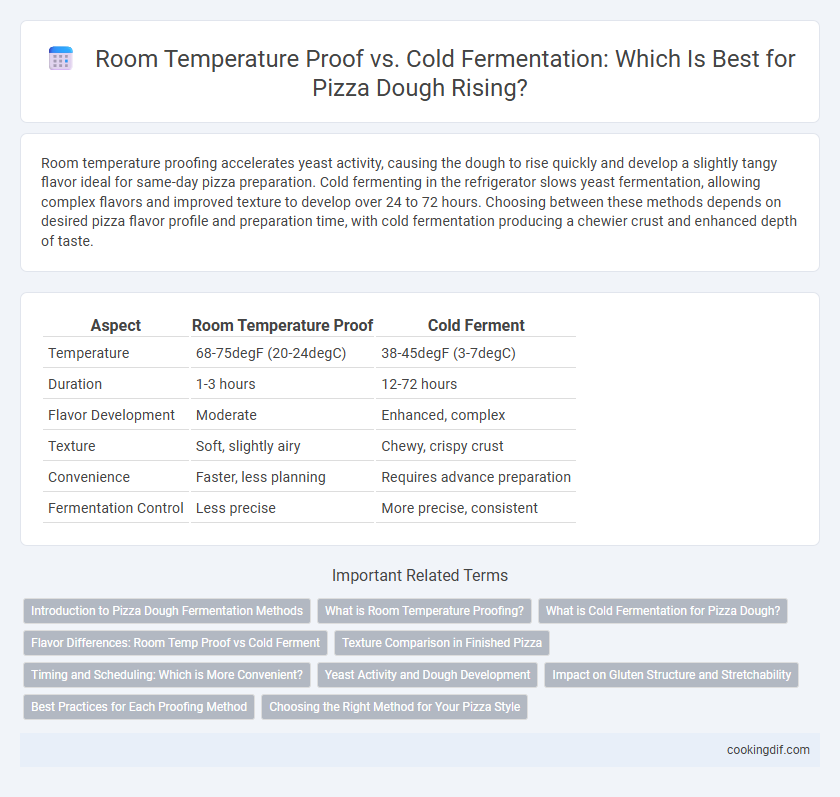Room temperature proofing accelerates yeast activity, causing the dough to rise quickly and develop a slightly tangy flavor ideal for same-day pizza preparation. Cold fermenting in the refrigerator slows yeast fermentation, allowing complex flavors and improved texture to develop over 24 to 72 hours. Choosing between these methods depends on desired pizza flavor profile and preparation time, with cold fermentation producing a chewier crust and enhanced depth of taste.
Table of Comparison
| Aspect | Room Temperature Proof | Cold Ferment |
|---|---|---|
| Temperature | 68-75degF (20-24degC) | 38-45degF (3-7degC) |
| Duration | 1-3 hours | 12-72 hours |
| Flavor Development | Moderate | Enhanced, complex |
| Texture | Soft, slightly airy | Chewy, crispy crust |
| Convenience | Faster, less planning | Requires advance preparation |
| Fermentation Control | Less precise | More precise, consistent |
Introduction to Pizza Dough Fermentation Methods
Room temperature proofing accelerates yeast activity, resulting in faster dough rise and a softer texture, ideal for same-day pizza preparation. Cold fermentation slows yeast fermentation in the refrigerator, enhancing flavor complexity and dough strength over 24 to 72 hours. Choosing between these methods depends on desired dough characteristics, timing, and flavor development preferences in artisan pizza making.
What is Room Temperature Proofing?
Room temperature proofing allows pizza dough to rise naturally at ambient indoor temperatures, typically between 68degF and 72degF, promoting yeast activity and gluten development without refrigeration. This method accelerates fermentation, yielding a softer texture and faster preparation time compared to cold fermenting, which slows yeast growth for enhanced flavor complexity. Optimal proofing times vary depending on dough hydration and yeast quantity, commonly ranging from 1 to 3 hours.
What is Cold Fermentation for Pizza Dough?
Cold fermentation for pizza dough is a slow fermentation process that occurs in the refrigerator at temperatures between 37degF and 45degF (3degC to 7degC). This method enhances dough flavor by allowing yeast activity to develop complex organic compounds over 24 to 72 hours or longer. Compared to room temperature proofing, cold fermentation slows fermentation rates, resulting in better texture, improved gluten structure, and a deeper, more nuanced taste profile in the finished pizza crust.
Flavor Differences: Room Temp Proof vs Cold Ferment
Room temperature proofing accelerates yeast activity, producing a dough with a mild, yeasty flavor but less complexity. Cold fermenting dough over 24-72 hours allows slower fermentation, enhancing flavor development with pronounced tanginess and a richer, more nuanced aroma. This extended process promotes the formation of organic acids and alcohols, significantly improving the depth and character of the pizza crust.
Texture Comparison in Finished Pizza
Room temperature proofing produces a softer, more uniform crumb structure, resulting in a tender crust with moderate chewiness. Cold fermentation enhances gluten development and enzymatic activity, creating a more complex texture characterized by a crispier crust and pronounced air pockets. The choice between room temperature proof and cold ferment directly impacts the pizza's final texture, balancing between softness and crunch.
Timing and Scheduling: Which is More Convenient?
Room temperature proofing typically takes 1 to 2 hours, making it ideal for quick preparation and same-day baking, while cold fermenting requires 24 to 72 hours in the refrigerator, allowing for flexible scheduling and enhanced flavor development. Cold fermentation fits well into a planned routine by developing dough flavor slowly overnight or over several days, freeing up active preparation time. Room temperature proofing demands immediate attention, better suited for last-minute baking projects or when short on time.
Yeast Activity and Dough Development
Room temperature proofing accelerates yeast activity, producing a faster rise and softer crumb within 1-2 hours, ideal for immediate baking needs. Cold fermentation slows yeast activity for 24-72 hours, enhancing dough flavor, gluten structure, and texture through gradual enzymatic development. Both methods influence dough development distinctly, with room temperature proofing prioritizing speed and cold fermentation optimizing flavor complexity and chewiness.
Impact on Gluten Structure and Stretchability
Room temperature proofing encourages rapid yeast activity, resulting in a looser gluten network that enhances immediate dough stretchability but may compromise long-term elasticity. Cold fermentation slows yeast fermentation, promoting stronger gluten development and a more open crumb structure, which improves dough extensibility and flavor complexity over time. Optimal gluten structure from cold fermented dough provides superior stretchability, making it ideal for achieving a balanced texture in artisan pizza crusts.
Best Practices for Each Proofing Method
Room temperature proofing accelerates yeast activity, resulting in a faster rise and a softer dough texture ideal for same-day pizza baking. Cold fermenting slows fermentation in the refrigerator, enhancing flavor complexity and dough elasticity through prolonged yeast metabolism. Best practices include monitoring dough temperature closely for room proofing and extending cold fermentation between 24 to 72 hours to maximize gluten development and taste.
Choosing the Right Method for Your Pizza Style
Room temperature proofing accelerates yeast activity, producing a softer crust ideal for traditional Neapolitan pizzas with a tender, airy crumb. Cold fermenting dough in the refrigerator over 24-72 hours develops complex flavors and a chewier texture, perfect for artisanal, sourdough, or New York-style pizzas. Selecting the right proofing method depends on your desired crust texture and flavor intensity, balancing rapid rise with depth of taste.
Room temperature proof vs cold ferment for rising Infographic

 cookingdif.com
cookingdif.com